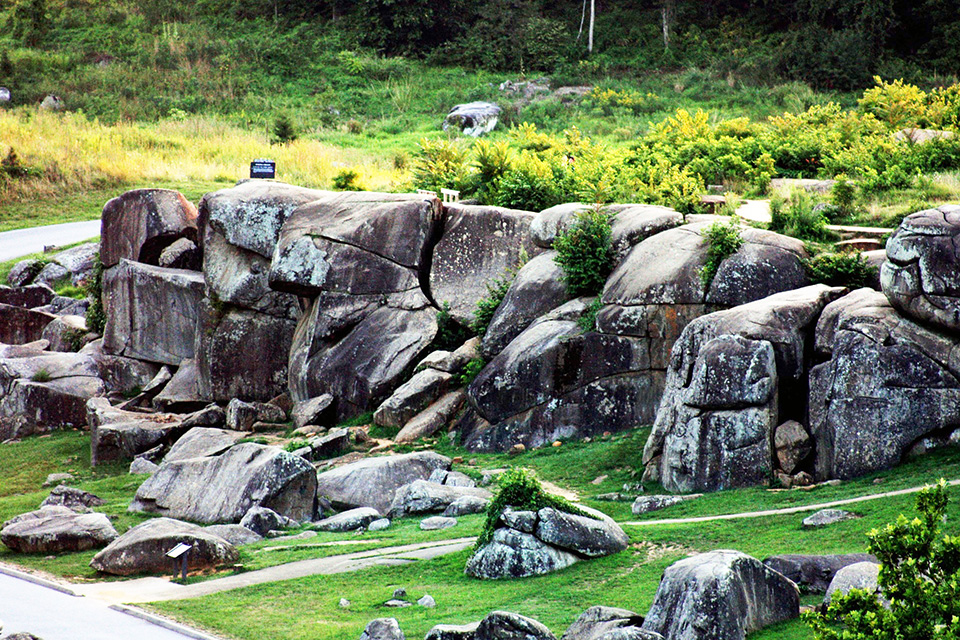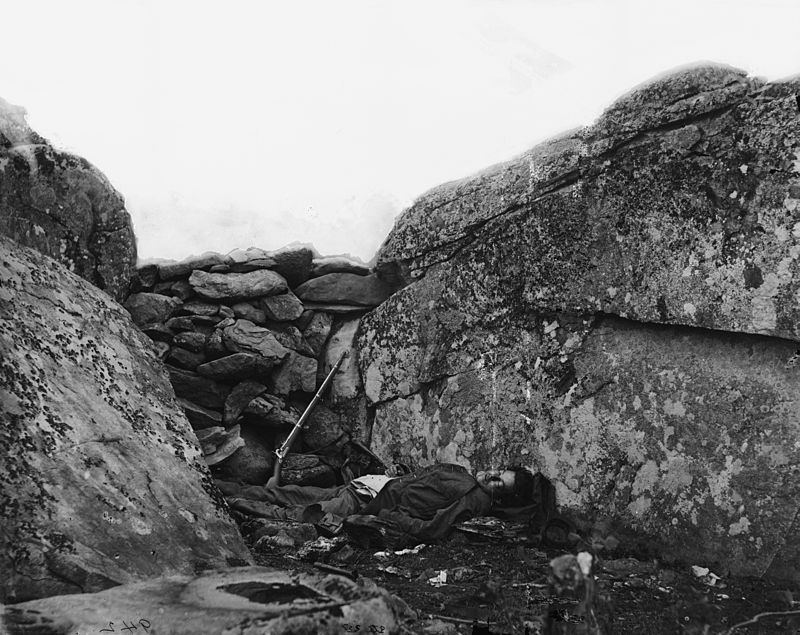
The Devil’s Den: Exploring the Key to Little Round Top
January 28, 2023One of the most famous battlefield locations at Gettysburg is Devil’s Den, a boulder-strewn hill rock formation located on the southmost end of Houck’s Ridge, about 500 yards west of the hill known as Little Round Top. Used extensively as a firing position by artillery and sharpshooters on the second day of the Battle of Gettysburg, it was the scene of some of the bloodiest fighting of the war and is an important stop on battlefield tours of the area.
Before the Battle
Some early local accounts suggest the site was formerly a Native American hunting ground and was alleged to have been the site of a bloody First Nation incident called “The Battle of the Crows.” It’s well known that the name “Devil’s Den” was already in use long before the battle of Gettysburg in 1863. Legend has it that local residents once believed that crevices between the boulders there were home to an enormous snake. The snake was supposedly nicknamed “The Devil,” resulting in the entire area being dubbed “Devil’s Den.” Despite the eccentricities of local legend, the true origin of the name is uncertain.
During the Battle
On July 2, 1863, the second day of the battle, the area around Devil’s Den was the site of intense fighting when General Longstreet’s Confederate corps attacked the divisions of General Sickles’ III Corps of the Army of the Potomac. Roughly 5,500 Confederates managed to capture Devil’s Den from 2,400 Union defenders, providing one of the few military successes of the Confederate forces at Gettysburg that day.
The Fighting at Devil’s Den
The rugged terrain of Devil’s Den is situated in an angle between Plum Run stream and an adjoining brook. Plum Run stream creates a marshy valley, difficult to navigate on foot. Many of the boulders that make up Devil’s Den are over 20 feet high.
Early in the day, Federal troops were dispatched from the southern end of the Union position on Cemetery Ridge to occupy what they believed to be a better position comprised by a wheatfield, the peach orchard just north of it, and Devil’s Den itself. One brigade occupied the area along Emmitsburg Road nearby, and four artillery pieces were positioned in support.
Around 4:00 p.m., a Confederate division launched an assault, striking the Federal line west of Devil’s Den while simultaneously advancing through Plum Run Valley on the east side. Intense fighting followed, and Union reinforcements were called in to hold the position.
A second Confederate wave attempted to exploit a gap in the Union lines adjoining the wheatfield, but they were repulsed.
After hours of savage fighting, Confederate forces captured three of the Union guns. Federal troops were pulled back from the wheatfield to engage the enemy in an area that came to be known as the “Slaughter Pen,” and to cover the retreat of their artillery from the hill.
Confederate sharpshooters pursued the Union retreat by moving into the boulder-strewn Devil’s Den, this new vantage point let them fire directly into the Federal position on nearby Little Round Top with brutal accuracy. In response, Union artillery on Little Round Top counter-fired on the Confederate sharpshooters, and many were killed by the blast concussion from the cannon fire as it was amplified by the surrounding rocks.
By the end of the day, Confederate forces maintained their control of Devil’s Den, pinning down Union movement on multiple adjoining fronts and occupying the area for the next 22 hours. Further action there wound down to a bloody standstill until the battle ended, after which Confederate forces withdrew and finally left the area.
All in all, Devil’s Den was the location of more than 1,800 Confederate deaths, with over 800 slain on the Union side. A bloody day indeed.

After The Battle
In the aftermath of the battle, the surrounding area gained notoriety for the truly gruesome scenes that accompanied the clean-up of the site, when it became clear just how vicious was the fighting among those picturesque boulders.
Various monuments were dedicated on the site from 1884 and onward. In the following years, various roads were constructed to provide direct access to the site (including an electric railway that operated nearby from 1894-1916). A comfort station was built to serve battlefield visitors in 1933 and operated until 2009. In 1988 a “Devil’s Den Access Committee” was formed to manage and protect the site, and its tablet was designated a Historic District Contributing Structure in 2004. The Devil’s Den barricade is officially listed on the Gettysburg National Military Park’s List of Classified Structures.
The Haunts at Devil’s Den
Devil’s Den, to this day, is reputed to be one of the most active haunted locations on the Gettysburg Battlefield.
Within a few hours of the cessation of fighting at Devil’s Den, while the battle raged on elsewhere, some Confederates were dispatched to stand guard among the boulders at night. Many of them later spoke about unnerving, supernatural experiences they shared throughout their vigil.
The carnage that took place ain and around this bouldered outcropping, coupled with its picturesque and sometimes eerie setting, has given rise to numerous reports of hauntings in the years since the battle. Ghost photos and reports of phantom encounters are a regular occurrence in the area, and even the hardiest of skeptics can agree that the Devil’s Den has an unsettling atmosphere, in the proper circumstances.

Visit Devil’s Den
A tourist attraction since the memorial association era, several of the larger boulders are worn from foot traffic. The site includes numerous cannons, memorials, and visitor walkways, including a bridge spanning two boulders. It is easily accessible and can be explored by the whole family.
Map of the Area near Devil’s Den
Following is a Google Map showing the location of Devil’s Den and other nearby landmarks at Gettysburg National Park:
Devil’s Den Map & Nearby Landmarks
Monuments Nearby
In addition to the fascinating history of the famed battlefield itself, a visit to Gettysburg National Park offers the opportunity to see more than 1,300 monuments on the battlefield. Following is a list of important monuments located in the vicinity of Devil’s Den:
- Monument to the 86th New York Volunteer Infantry Regiment
- Monument to the 2nd Brigade, 1st Division, 3rd Corps
- Monument to the 124th New York Volunteer Infantry Regiment “The Orange Blossoms”
- Monument to the 99th Pennsylvania Volunteer Infantry Regiment
- Monument to the 4th New York Independent Battery
- Monument to Robertson’s Brigade of the Army of Northern Virginia
- Monument to Benning’s Georgia Brigade
- Main monument to the 4th Maine Volunteer Infantry Regiment
- Monument to the 6th New Jersey Volunteer Infantry Regiment
- Monument to the 40th New York Volunteer Infantry Regiment “Mozart Regiment”
Visit Devil’s Den in Person
Plan your next excursion with us! Our bus tours of the historic Gettysburg Battlefield are active and ready to show you the sites of the historical battleground. Reservations can be made by calling our toll-free number at 877-680-8687. You can also purchase bus tour tickets online. Tours depart from the Gettysburg Tour Center located at 778 Baltimore Street across from the National Cemetery.
